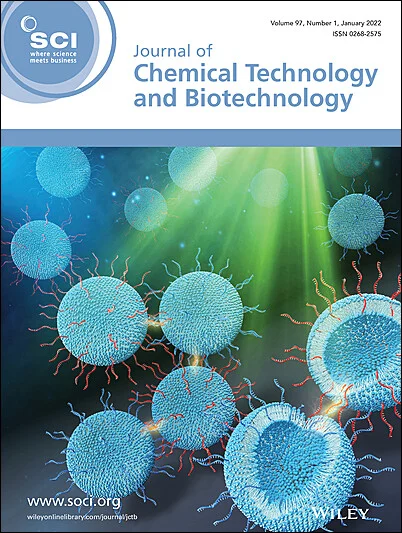Tamara Janković, Adrie J. J. Straathof, Siddhant Sharma, Anton A. Kiss
下载PDF
{"title":"从发酵液中高效回收非挥发性产物:脂肪族二醇","authors":"Tamara Janković, Adrie J. J. Straathof, Siddhant Sharma, Anton A. Kiss","doi":"10.1002/jctb.70040","DOIUrl":null,"url":null,"abstract":"<p>Fermentation can be used to obtain a wide variety of valuable high-boiling components. Among these components, microorganisms can produce aliphatic diols (e.g. propanediols, butanediols, etc.) in significant concentrations (e.g. 5–15 wt.%). Nonetheless, the high boiling points of these components, presence of microorganisms, and formation of by-products complicate recovery after fermentation. Hence, this perspective offers valuable insights into downstream processing options. A novel methodology was developed for recovering high-boiling components from dilute aqueous solutions, whereby both light and heavy impurities are present. The main steps in the proposed methodology are heat pump-assisted preconcentration and final purification in a dividing-wall column. These steps allow effective separation of high-purity product from water, light and heavy impurities. Furthermore, processes for recovery of 1,3-propanediol, 2,3-, 1,4- and 1,3-butanediol, designed according to the proposed methodology, were compared. Downstream processing performance is mainly determined by the product concentration in the fermentation broth, but is also influenced by the amount of impurities in the broth. © 2025 The Author(s). <i>Journal of Chemical Technology and Biotechnology</i> published by John Wiley & Sons Ltd on behalf of Society of Chemical Industry (SCI).</p>","PeriodicalId":15335,"journal":{"name":"Journal of chemical technology and biotechnology","volume":"100 11","pages":"2245-2250"},"PeriodicalIF":2.4000,"publicationDate":"2025-08-12","publicationTypes":"Journal Article","fieldsOfStudy":null,"isOpenAccess":false,"openAccessPdf":"https://scijournals.onlinelibrary.wiley.com/doi/epdf/10.1002/jctb.70040","citationCount":"0","resultStr":"{\"title\":\"Eco-efficient recovery of non-volatile products from fermentation broth: aliphatic diols\",\"authors\":\"Tamara Janković, Adrie J. J. Straathof, Siddhant Sharma, Anton A. Kiss\",\"doi\":\"10.1002/jctb.70040\",\"DOIUrl\":null,\"url\":null,\"abstract\":\"<p>Fermentation can be used to obtain a wide variety of valuable high-boiling components. Among these components, microorganisms can produce aliphatic diols (e.g. propanediols, butanediols, etc.) in significant concentrations (e.g. 5–15 wt.%). Nonetheless, the high boiling points of these components, presence of microorganisms, and formation of by-products complicate recovery after fermentation. Hence, this perspective offers valuable insights into downstream processing options. A novel methodology was developed for recovering high-boiling components from dilute aqueous solutions, whereby both light and heavy impurities are present. The main steps in the proposed methodology are heat pump-assisted preconcentration and final purification in a dividing-wall column. These steps allow effective separation of high-purity product from water, light and heavy impurities. Furthermore, processes for recovery of 1,3-propanediol, 2,3-, 1,4- and 1,3-butanediol, designed according to the proposed methodology, were compared. Downstream processing performance is mainly determined by the product concentration in the fermentation broth, but is also influenced by the amount of impurities in the broth. © 2025 The Author(s). <i>Journal of Chemical Technology and Biotechnology</i> published by John Wiley & Sons Ltd on behalf of Society of Chemical Industry (SCI).</p>\",\"PeriodicalId\":15335,\"journal\":{\"name\":\"Journal of chemical technology and biotechnology\",\"volume\":\"100 11\",\"pages\":\"2245-2250\"},\"PeriodicalIF\":2.4000,\"publicationDate\":\"2025-08-12\",\"publicationTypes\":\"Journal Article\",\"fieldsOfStudy\":null,\"isOpenAccess\":false,\"openAccessPdf\":\"https://scijournals.onlinelibrary.wiley.com/doi/epdf/10.1002/jctb.70040\",\"citationCount\":\"0\",\"resultStr\":null,\"platform\":\"Semanticscholar\",\"paperid\":null,\"PeriodicalName\":\"Journal of chemical technology and biotechnology\",\"FirstCategoryId\":\"5\",\"ListUrlMain\":\"https://scijournals.onlinelibrary.wiley.com/doi/10.1002/jctb.70040\",\"RegionNum\":4,\"RegionCategory\":\"生物学\",\"ArticlePicture\":[],\"TitleCN\":null,\"AbstractTextCN\":null,\"PMCID\":null,\"EPubDate\":\"\",\"PubModel\":\"\",\"JCR\":\"Q3\",\"JCRName\":\"BIOTECHNOLOGY & APPLIED MICROBIOLOGY\",\"Score\":null,\"Total\":0}","platform":"Semanticscholar","paperid":null,"PeriodicalName":"Journal of chemical technology and biotechnology","FirstCategoryId":"5","ListUrlMain":"https://scijournals.onlinelibrary.wiley.com/doi/10.1002/jctb.70040","RegionNum":4,"RegionCategory":"生物学","ArticlePicture":[],"TitleCN":null,"AbstractTextCN":null,"PMCID":null,"EPubDate":"","PubModel":"","JCR":"Q3","JCRName":"BIOTECHNOLOGY & APPLIED MICROBIOLOGY","Score":null,"Total":0}
引用次数: 0
引用
批量引用


 求助内容:
求助内容: 应助结果提醒方式:
应助结果提醒方式:


